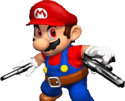Cool. My visualization is of a red laser between my right eye and the target. I don't always do it but it is helpful sometimes, especially so when working any variety of press-out. It reminds me where I want the gun to be and helps me put the gun on the spot I want to hit instead of some other spot. I imagine it in binocular vision, so I see a solid red dot on the spot I want to hit (imaginary dominant image) and a left-angled view of the solid beam (imaginary nondominant image.)
That's the part you need to work on (based on what's been said in this thread.) I've done this two ways and benefited from both I think.
One, the conventional way: when you are paying attention to those sights, instead of allowing (easier said than done, I know) your mind to say "NOW", feel pleasure at the fact that you've aligned the gun well enough to hit. Make seeing a sight picture that says you will hit your truest goal, the one thing you want, and a source of actual joy. I think this might happen naturally if you are emotionally invested in your shooting performance. And continue improving the sight picture as you continuously add pressure to the trigger. The gun will fire when everyone is ready. By everyone, I mean you, the trigger, and the sight picture. Not succumbing to the mind saying 'NOW' is to have visual patience. And that's what I am hearing you need, based on your statement only of course. Be process-oriented, not result-oriented. To say 'NOW' is to be result-oriented. To have the discipline to continuously improve the sight picture and add pressure to the trigger is to be process-oriented. The process will lead to the result, so focus on the process and know the result will be there. Focusing on the result doesn't get the result as well.
Two, the unconventional way: turn traditional marksmanship and what I just said on its head, and practice pressing the trigger 'NOW', and without moving the gun. I think this is a natural progression of pulling the trigger faster and faster in that wall-type drill we are discussing. Eventually you will be stroking through the trigger quickly enough that it amounts to 'NOW.' Some really tight combinations of space and time lead to 'NOW' being the only way to effectively engage a target. Sometimes you screw up and finish the trigger press 'NOW' even when you know better. Cultivating a better 'NOW', abrupt trigger press mitigates the error when you do it even though you shouldn't, and might allow you to engage something that is otherwise outside of your skill envelope. It's just another way to attack the trigger press.





 Reply With Quote
Reply With Quote


